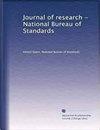Pharmaceutical Trace Analysis
Journal of research of the National Bureau of Standards
Pub Date : 1988-05-01
DOI:10.6028/jres.093.031
引用次数: 0
Abstract
of an analyte specific clean-up is useful in minimizing this problem. Identification of the species producing the effect and application of specific clean-up steps can eliminate problems. Low results can result from incomplete analyte extraction, loss or degradation of the analyte during sample clean-up, or matrix effects. These problems can be eliminated by a careful evaluation of each of the steps employed in the sample preparation. 1) Extraction efficiencies can be improved by dissolving the sample matrix whenever possible and determining the optimum solvent for analyte extraction. When dissolution of the matrix is not practical, an exhaustive extraction procedure with an optimum solvent should be used. 2) Loss or degradation of the analyte can be controlled by determining the recoveries of all analytes through each clean-up step. An understanding of the chemical and physical properties of the analyte will not only improve recoveries, but also can allow optimization of each clean-up step. 3) Matrix effects leading to low results generally are caused by exceeding the capacity of the clean-up procedure for either analytes, related compounds, or coextractive species. This "overloading" can change the chromatographic retention of the analyte. In general, these effects can be minimized by decreasing the sample size or using a highcapacity pretreatment step to remove the coextractives. Application of these precautions can result in a method which does not generate false positive or false negative results. A recent collaborative study to determine fortified levels of CDDs and CDFs in human adipose tissue at 5-50 pg/g has been completed by eight laboratories highly experienced in the determination of CDDs and CDFs [Albro et al., Anal. Chem. 57, 2717 (1985)]. By implementing the practices described above, laboratory 2 avoided generating either unaccountably high or low results (table 1). The apparent drawback of the laboratory 2 method is the relatively long analysis time per sample. However, when the standard deviation of the recoveries for each laboratory is calculated and used in the equation to determine the relative time to analyze N samples (measurements necessary to yield data of defined statistical reliability), method 2 can actually generate data with a specified precision in the shortest time. Table 1. Interpretation of recovery data from CDD/CDF collaborative study药物痕量分析
对分析物进行特定的清理有助于减少这个问题。确定产生影响的物种和应用特定的清理步骤可以消除问题。低结果可能是由于分析物提取不完全,样品清理过程中分析物丢失或降解,或基质效应。这些问题可以通过仔细评估样品制备中采用的每个步骤来消除。1)通过尽可能溶解样品基质和确定萃取分析物的最佳溶剂,可以提高萃取效率。当基质的溶解不可行时,应使用最佳溶剂的穷举萃取程序。2)通过每个清理步骤确定所有分析物的回收率,可以控制分析物的损失或降解。了解分析物的化学和物理性质不仅可以提高回收率,还可以优化每个清理步骤。3)基质效应导致低结果通常是由于超出了对分析物、相关化合物或共萃取物清理程序的能力。这种“超载”会改变分析物的色谱保留。一般来说,这些影响可以通过减少样本量或使用高容量预处理步骤来去除共萃取物来最小化。这些预防措施的应用可以产生一种不产生假阳性或假阴性结果的方法。最近,8个在检测cdd和CDFs方面经验丰富的实验室完成了一项合作研究,以确定人体脂肪组织中cdd和CDFs的强化水平(5-50 pg/g) [Albro等人,Anal]。化学,57,2717(1985)]。通过实施上述实践,实验室2避免产生不可解释的高或低结果(表1)。实验室2方法的明显缺点是每个样品的分析时间相对较长。然而,当计算每个实验室的回收率的标准偏差并将其用于公式中以确定分析N个样品的相对时间(产生定义的统计可靠性数据所需的测量)时,方法2实际上可以在最短的时间内生成具有指定精度的数据。表1。CDD/CDF合作研究中恢复数据的解释
本文章由计算机程序翻译,如有差异,请以英文原文为准。
求助全文
约1分钟内获得全文
求助全文

 求助内容:
求助内容: 应助结果提醒方式:
应助结果提醒方式:


